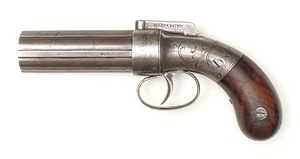Ethan Allen (armsmaker)
| Ethan Allen | |
|---|---|
| Born |
Ethan Allen September 2, 1808 Bellingham, Massachusetts, United States |
| Died |
January 7, 1871 (aged 64) Massachusetts, United States |
| Occupation | Inventor, businessman |
| Spouse(s) | Mary Harrington, Sarah Mary Johnson |
| Children | Nettie |

Ethan Allen (September 2, 1808– January 7, 1871) was a major American arms maker from Massachusetts. He is unrelated to the revolutionary Ethan Allen. His first firearm, the "Pocket Rifle" was developed in 1836, and his first patent was granted in 1837. He went into partnership with his brother-in-law, Charles Thurber.
Early life
Allen began his career as a cutlery maker in Milford, Massachusetts in 1831. He gained the knowledge of metalworking and manufacturing processes by producing knives and shoemaking tools before moving his business to Grafton.[1]
While working on a cane gun for a doctor, Allen came up with the idea for an underhammer pocket rifle and designed it in 1836. The following year he applied for a patent for a "tube hammer" pocket pistol and went into business with his two brothers-in-law, Charles Thurber and Thomas P. Wheelock as Allen & Thurber. Thurber was a partner and Wheelock was an engineer and designer.[1]
Firearms
Initially Allen's firm manufactured single-shot pistols and rifles, but eventually moved on to early revolvers. The Allen & Thurber Pepper-box, known as the "Gun that won the East", was the most common repeating handgun of its day.[2]
In 1843 he and Thurber relocated to Norwich, Connecticut and in addition to armsmaking, built prototypes of Thurber's typewriter designed for the blind, disabled and those “nervous” about writing by hand. Though patented, the typewriter was never manufactured for commercial sale.[3]
In 1847, the company moved to Worcester, Massachusetts, and in 1854 Wheelock became an equal partner with the firm's name changing to Allen Thurber & Co. In 1856, following Thurber's death, they reorganized as Allen & Wheelock and developed a single-action revolver bearing their names.[4]
After the death of Wheelock in 1865, his 2 sons-in-law, Sullivan Forehand and H. C. Wadsworth, began working for him and the company changed names to Allen & Company. Upon Allen's death in 1871 the two operated the company under their own names: Forehand & Wadsworth, until Forehand reorganized the company in 1890 as the Forehand Arms Company after Wadsworth's retirement.[5]
Trade names
- 1831–1837: E. Allen (Grafton)
- 1837–1842: Allen & Thurber (Grafton)
- 1842–1847: Allen & Thurber (Norwich)
- 1847–1854: Allen & Thurber (Worcester)
- 1854–1856: Allen Thurber & Co (Worcester)
- 1856–1865: Allen & Wheelock (Worcester)
- 1865–1871: E. Allen & Company (Worcester)
References
- ↑ 1.0 1.1 Flayderman, Norm (3 December 2007). Flayderman's Guide to Antique American Firearms and Their Values. Iola, Wisconsin: F+W Media, Inc. p. 51. ISBN 1-4402-2422-6.
- ↑ Lawes, Carolyn J. Women and Reform in a New England Community, 1815-1860. University Press of Kentucky. pp. 94–95. ISBN 0-8131-2739-4.
- ↑ Traister, John E. (1994). Antique guns: the collector's guide. Stoeger Publishing Company. ISBN 978-0-88317-175-2.
- ↑ Lee, Jerry (15 November 2011). Standard Catalog of Rifles & Shotguns. Iola, Wisconsin: Gun Digest Books. p. 43. ISBN 1-4402-3014-5.
- ↑ Collections of the Worcester Society of Antiquity. Worcester, Ma: The Society. 1899. pp. 322–329.
- The Story of Allen & Wheelock Firearms - H. H. Thomas (1965) (ISBN 0-913150-73-8)
- Ethen Allen, Gunmaker: His Partners, Patents and Firearms - Harold Mouillesseaux (1973) (ISBN 0-919316-68-9)
|